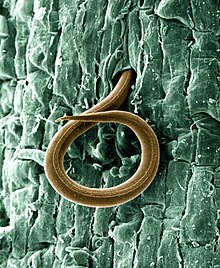Meloidogyne
| Root-knot nematode | |
|---|---|
 |
|
| Larva of root-knot nematode, Meloidogyne incognita, magnified 500×, shown here penetrating a tomato root | |
| Scientific classification | |
| Kingdom: | Animalia |
| Phylum: | Nematoda |
| Class: | Secernentea |
| Order: | Tylenchida |
| Family: | Meloidogynidae |
| Genus: |
Meloidogyne Göldi, 1889 |
| Species | |
|
Meloidogyne hapla |
|
Meloidogyne hapla
Meloidogyne incognita
Meloidogyne enterolobii syn. M. mayaguensis
...
Root-knot nematodes are plant-parasitic nematodes from the genus Meloidogyne. They exist in soil in areas with hot climates or short winters. About 2000 plants worldwide are susceptible to infection by root-knot nematodes and they cause approximately 5% of global crop loss. Root-knot nematode larvae infect plant roots, causing the development of root-knot galls that drain the plant's photosynthate and nutrients. Infection of young plants may be lethal, while infection of mature plants causes decreased yield.
Root-knot nematodes (Meloidogyne spp.) are one of the three most economically damaging genera of plant-parasitic nematodes on horticultural and field crops. Root-knot nematodes are distributed worldwide, and are obligate parasites of the roots of thousands of plant species, including monocotyledonous and dicotyledonous, herbaceous and woody plants. The genus includes more than 90 species, with some species having several races. Four Meloidogyne species (M. javanica, M. arenaria, M. incognita, and M. hapla) are major pests worldwide, with another seven being important on a local basis.Meloidogyne occurs in 23 of 43 crops listed as having plant-parasitic nematodes of major importance, ranging from field crops, through pasture and grasses, to horticultural, ornamental and vegetable crops. If root-knot nematodes become established in deep-rooted, perennial crops, control is difficult and options are limited.
Meloidogyne spp. were first reported in cassava by Neal in 1889. Damage on cassava is variable depending on cultivar planted, and can range from negligible to serious. Early-season infection leads to worse damage. In most crops, nematode damage reduces plant health and growth; in cassava, though, nematode damage sometimes leads to increased aerial growth as the plants try to compensate. This possibly enables the plant to maintain a reasonable level of production. Therefore, aerial correlations to nematode density can be positive, negative or not at all.Vegetable crops grown in warm climates can experience severe losses from root-knot nematodes, and are often routinely treated with a chemical nematicide. Root-knot nematode damage results in poor growth, a decline in quality and yield of the crop and reduced resistance to other stresses (e.g. drought, other diseases). A high level of damage can lead to total crop loss. Nematode-damaged roots do not use water and fertilisers as effectively, leading to additional losses for the grower. In cassava, it has been suggested that levels of Meloidogyne spp. that are sufficient to cause injury rarely occur naturally. However, with changing farming systems, in a disease complex or weakened by other factors, nematode damage is likely to be associated with other problems.
...
Wikipedia
